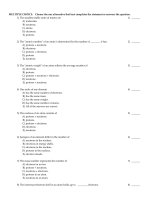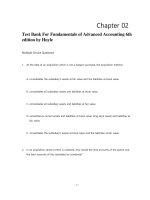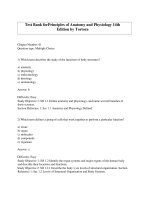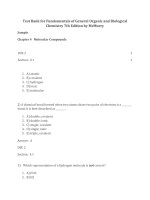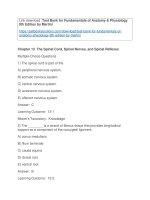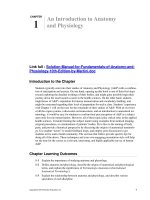Test bank for fundamentals of anatomy and physiology 11e c21
Bạn đang xem bản rút gọn của tài liệu. Xem và tải ngay bản đầy đủ của tài liệu tại đây (985.07 KB, 50 trang )
Chapterȱ21 BloodȱVesselsȱandȱCirculation
Multiple Choice Questions
1) Theȱmuscularȱlayerȱinȱtheȱwallȱofȱaȱbloodȱvesselȱisȱtheȱtunica
A) intima.
B) externa.
C) media.
D) interna.
E) adventitia.
Answer: C
LearningȱOutcome: 21-1
BloomȇsȱTaxonomy: Remembering
2) Comparedȱtoȱarteries,ȱveins
A) areȱrounderȱinȱaȱsectionalȱcut.
B) haveȱmoreȱsmoothȱmuscleȱinȱtheirȱtunicaȱmedia.
C) haveȱaȱpleatedȱendothelium.
D) haveȱthinnerȱwalls.
E) holdȱtheirȱshapeȱbetterȱwhenȱcut.
Answer: D
LearningȱOutcome: 21-1
BloomȇsȱTaxonomy: Remembering
3) Capillariesȱthatȱhaveȱaȱcompleteȱliningȱareȱcalled
A) continuousȱcapillaries.
B) fenestratedȱcapillaries.
C) sinusoidalȱcapillaries.
D) sinusoids.
E) vasaȱvasorum.
Answer: A
LearningȱOutcome: 21-1
BloomȇsȱTaxonomy: Remembering
4) Theȱsmallestȱarterialȱbranchesȱareȱcalledȱthe
A) muscularȱarteries.
B) arterioles.
C) capillaries.
D) venules.
E) veins.
Answer: B
LearningȱOutcome: 21-1
BloomȇsȱTaxonomy: Remembering
Copyrightȱ©ȱ2018ȱPearsonȱEducation,ȱInc.
696ȱȱȱTestȱBankȱforȱFundamentalsȱofȱAnatomyȱ&ȱPhysiology,ȱ11e
5) Theȱlayerȱbetweenȱtheȱtunicaȱmediaȱandȱtheȱtunicaȱexternaȱinȱaȱlargeȱarteryȱisȱthe
A) tunicaȱintima.
B) externalȱelasticȱmembrane.
C) tunicaȱmedia.
D) internalȱelasticȱmembrane.
E) tunicaȱexterna.
Answer: B
LearningȱOutcome: 21-1
BloomȇsȱTaxonomy: Remembering
6) Whichȱofȱtheȱfollowingȱlayersȱofȱaȱvesselȱcontainsȱcollagenȱfibersȱwithȱscatteredȱbandsȱof
elasticȱfibers?
A) tunicaȱintima
B) externalȱelasticȱmembrane
C) tunicaȱmedia
D) internalȱelasticȱmembrane
E) tunicaȱexterna
Answer: E
LearningȱOutcome: 21-1
BloomȇsȱTaxonomy: Remembering
7) Afterȱbloodȱleavesȱtheȱcapillaries,ȱitȱentersȱthe
A) arteries.
B) arterioles.
C) capillaries.
D) venules.
E) veins.
Answer: D
LearningȱOutcome: 21-1
BloomȇsȱTaxonomy: Remembering
8) Whichȱlayerȱofȱaȱbloodȱvesselȱcontainsȱconcentricȱsheetsȱofȱsmoothȱmuscleȱtissue?
A) tunicaȱintima
B) externalȱelasticȱmembrane
C) tunicaȱmedia
D) internalȱelasticȱmembrane
E) tunicaȱexterna
Answer: C
LearningȱOutcome: 21-1
BloomȇsȱTaxonomy: Remembering
9) Theȱlargeȱvesselsȱthatȱreturnȱbloodȱtoȱtheȱheartȱareȱcalled
A) arteries.
B) arterioles.
C) capillaries.
D) venules.
E) veins.
Answer: E
LearningȱOutcome: 21-1
BloomȇsȱTaxonomy: Remembering
Copyrightȱ©ȱ2018ȱPearsonȱEducation,ȱInc.
Chapterȱ21ȱȱBloodȱVesselsȱandȱCirculationȱȱȱ 697
10) Inȱarteries,ȱtheȱthickȱlayerȱofȱelasticȱfibersȱassociatedȱwithȱtheȱtunicaȱintimaȱisȱcalledȱthe
A) tunicaȱintima.
B) externalȱelasticȱmembrane.
C) tunicaȱmedia.
D) internalȱelasticȱmembrane.
E) tunicaȱexterna.
Answer: D
LearningȱOutcome: 21-1
BloomȇsȱTaxonomy: Remembering
11) Whichȱofȱtheȱfollowingȱisȱtheȱinnermostȱlayerȱofȱaȱbloodȱvessel?
A) tunicaȱintima
B) externalȱelasticȱmembrane
C) tunicaȱmedia
D) internalȱelasticȱmembrane
E) tunicaȱexterna
Answer: A
LearningȱOutcome: 21-1
BloomȇsȱTaxonomy: Remembering
12) Venoconstrictionȱ________ȱtheȱamountȱofȱbloodȱwithinȱtheȱvenousȱsystem,ȱwhichȱ________ȱthe
volumeȱinȱtheȱarterialȱandȱcapillaryȱsystems.
A) doubles;ȱdecreases
B) reduces;ȱincreases
C) decreases;ȱdoubles
D) increases;ȱreduces
E) reduces;ȱreduces
Answer: B
LearningȱOutcome: 21-1
BloomȇsȱTaxonomy: Remembering
13) Venousȱvalvesȱareȱresponsibleȱfor
A) preventingȱanterogradeȱflow.
B) channelingȱbloodȱawayȱfromȱtheȱheart.
C) channelingȱbloodȱtowardȱtheȱheart.
D) preventingȱbloodȱfromȱre-enteringȱaȱventricle.
E) regulatingȱbloodȱpressureȱinȱveins.
Answer: C
LearningȱOutcome: 21-1
BloomȇsȱTaxonomy: Understanding
14) Venaeȱcavaeȱareȱtheȱlargestȱofȱwhatȱtypeȱofȱvessel?
A) artery
B) arteriole
C) capillary
D) venule
E) vein
Answer: E
LearningȱOutcome: 21-1
BloomȇsȱTaxonomy: Remembering
Copyrightȱ©ȱ2018ȱPearsonȱEducation,ȱInc.
698ȱȱȱTestȱBankȱforȱFundamentalsȱofȱAnatomyȱ&ȱPhysiology,ȱ11e
15) WhichȱofȱtheȱfollowingȱvesselsȱchangesȱdiameterȱmostȱreadilyȱtoȱlocalȱconditionsȱorȱSNS
stimulation?
A) elasticȱarteries
B) arterioles
C) fenestratedȱcapillaries
D) venules
E) veins
Answer: B
LearningȱOutcome: 21-1
BloomȇsȱTaxonomy: Understanding
16) Ofȱtheȱfollowing,ȱwhichȱisȱanȱelasticȱartery?
A) theȱsubclavian
B) theȱexternalȱcarotid
C) theȱbrachial
D) theȱfemoral
E) theȱulnar
Answer: A
LearningȱOutcome: 21-1
BloomȇsȱTaxonomy: Remembering
17) Youȱwouldȱexpectȱtoȱfindȱfenestratedȱcapillariesȱin
A) skeletalȱmuscles.
B) cardiacȱmuscle.
C) theȱpituitaryȱgland.
D) bone.
E) skin.
Answer: C
LearningȱOutcome: 21-1
BloomȇsȱTaxonomy: Understanding
18) Aȱsampleȱofȱtissueȱdisplaysȱmanyȱlargeȱflattenedȱspacesȱlinedȱbyȱfenestratedȱendothelium.
Bloodȱmovesȱslowlyȱthroughȱtheseȱspaces.ȱThisȱtissueȱsampleȱmostȱlikelyȱcameȱfromȱthe
A) heart.
B) lungs.
C) liver.
D) kidneys.
E) skin.
Answer: C
LearningȱOutcome: 21-1
BloomȇsȱTaxonomy: Understanding
Copyrightȱ©ȱ2018ȱPearsonȱEducation,ȱInc.
Chapterȱ21ȱȱBloodȱVesselsȱandȱCirculationȱȱȱ 699
19) Theseȱvesselsȱmayȱbeȱcontinuousȱorȱfenestrated.
A) arteries
B) arterioles
C) capillaries
D) venules
E) veins
Answer: C
LearningȱOutcome: 21-1
BloomȇsȱTaxonomy: Understanding
20) WhatȱstructureȱdoȱRBCsȱmoveȱthroughȱsingle-file?
A) artery
B) arteriole
C) capillary
D) venule
E) vein
Answer: C
LearningȱOutcome: 21-1
BloomȇsȱTaxonomy: Understanding
21) Capillariesȱwithȱaȱperforatedȱliningȱareȱcalled
A) perforatedȱcapillaries.
B) discontinuousȱcapillaries.
C) fenestratedȱcapillaries.
D) sinuses.
E) vasaȱvasorum.
Answer: C
LearningȱOutcome: 21-1
BloomȇsȱTaxonomy: Remembering
22) Exchangeȱbetweenȱaȱbloodȱvesselȱandȱtheȱcellsȱthatȱsurroundȱitȱcanȱoccurȱonlyȱin
A) arteries.
B) arterioles.
C) veins.
D) venules.
E) capillaries.
Answer: E
LearningȱOutcome: 21-1
BloomȇsȱTaxonomy: Remembering
23) Whichȱkindȱofȱvesselȱisȱalsoȱcalledȱaȱresistanceȱvessel?
A) artery
B) arteriole
C) capillary
D) venule
E) vein
Answer: B
LearningȱOutcome: 21-1
BloomȇsȱTaxonomy: Remembering
Copyrightȱ©ȱ2018ȱPearsonȱEducation,ȱInc.
700ȱȱȱTestȱBankȱforȱFundamentalsȱofȱAnatomyȱ&ȱPhysiology,ȱ11e
24) Bloodȱflowȱthroughȱaȱcapillaryȱisȱcontrolledȱbyȱthe
A) vasaȱvasorum.
B) plexus.
C) precapillaryȱsphincter.
D) thoroughfareȱchannel.
E) venule.
Answer: C
LearningȱOutcome: 21-1
BloomȇsȱTaxonomy: Remembering
25) Theȱcommonȱiliacȱarteryȱisȱanȱexampleȱofȱwhichȱtypeȱofȱartery?
A) arteriolar
B) elastic
C) connective
D) muscular
E) vascular
Answer: B
LearningȱOutcome: 21-1
BloomȇsȱTaxonomy: Remembering
26) Venoconstrictionȱreducesȱtheȱdiameterȱofȱwhichȱvessel?
A) artery
B) arteriole
C) capillary
D) venule
E) vein
Answer: E
LearningȱOutcome: 21-1
BloomȇsȱTaxonomy: Remembering
27) Theȱbrachialȱandȱfemoralȱarteriesȱareȱexamplesȱofȱwhichȱtypeȱofȱartery?
A) arteriolar
B) elastic
C) connective
D) muscular
E) vascular
Answer: D
LearningȱOutcome: 21-1
BloomȇsȱTaxonomy: Remembering
28) Whatȱvesselsȱcontainȱelasticȱfibersȱinȱtheȱwallsȱthatȱareȱstretchedȱduringȱsystole?
A) arteries
B) arterioles
C) capillaries
D) venules
E) veins
Answer: A
LearningȱOutcome: 21-1
BloomȇsȱTaxonomy: Understanding
Copyrightȱ©ȱ2018ȱPearsonȱEducation,ȱInc.
Chapterȱ21ȱȱBloodȱVesselsȱandȱCirculationȱȱȱ 701
29) Whichȱofȱtheȱfollowingȱisȱmostȱlikelyȱtoȱresultȱfromȱanȱaneurysmȱinȱaȱbrainȱartery?
A) hypotension
B) quadriplegia
C) stroke
D) myocardialȱinfarction
E) pulmonaryȱembolism
Answer: C
LearningȱOutcome: 21-1
BloomȇsȱTaxonomy: Applying
30) Complicationsȱrelatedȱtoȱarteriosclerosisȱaccountȱforȱroughlyȱ________ȱpercentȱofȱdeathsȱinȱthe
UnitedȱStates.
A) 30
B) 60
C) 20
D) 50
E) 25
Answer: D
LearningȱOutcome: 21-1
BloomȇsȱTaxonomy: Remembering
31) Arteriosclerosisȱcanȱleadȱtoȱallȱofȱtheȱfollowingȱexcept
A) hypertension.
B) stroke.
C) coronaryȱarteryȱdisease.
D) myocardialȱinfarction.
E) diabetes.
Answer: E
LearningȱOutcome: 21-1
BloomȇsȱTaxonomy: Understanding
32) Whichȱofȱtheȱfollowingȱareȱtheȱsmallest venousȱvessels?
A) largeȱveins
B) venules
C) mediumȱveins
D) arteriovenules
E) venousȱvalves
Answer: B
LearningȱOutcome: 21-1
BloomȇsȱTaxonomy: Remembering
33) Bloodȱmovesȱforwardȱthroughȱveinsȱbecauseȱofȱallȱofȱtheȱfollowingȱexcept
A) theȱpressureȱinȱtheȱveinsȱisȱlowerȱthanȱinȱtheȱarteries.
B) pumpingȱbyȱtheȱsmoothȱmuscleȱinȱtheȱwallȱofȱtheȱvein.
C) theȱrespiratoryȱpump.
D) valvesȱinȱtheȱveinsȱpreventingȱtheȱbackwardȱflowȱofȱblood.
E) muscularȱcompression.
Answer: B
LearningȱOutcome: 21-1
BloomȇsȱTaxonomy: Remembering
Copyrightȱ©ȱ2018ȱPearsonȱEducation,ȱInc.
702ȱȱȱTestȱBankȱforȱFundamentalsȱofȱAnatomyȱ&ȱPhysiology,ȱ11e
34) Whichȱpartȱofȱtheȱvascularȱsystemȱfunctionsȱasȱaȱbloodȱreservoirȱandȱcontainsȱoverȱ60%ȱofȱthe
bodyȇsȱblood?
A) pulmonaryȱarteries
B) capillaries
C) systemicȱarterioles
D) veins
E) arteries
Answer: D
LearningȱOutcome: 21-1
BloomȇsȱTaxonomy: Understanding
35) Whatȱisȱtheȱcorrectȱorderȱforȱtheȱsequenceȱofȱbloodȱvesselsȱthatȱbloodȱwouldȱtravelȱinȱthe
systemicȱcircuit,ȱstartingȱatȱtheȱaorta?
1.ȱvenules
2.ȱarterioles
3.ȱcapillaries
4.ȱelasticȱarteries
5.ȱmediumȱveins
6.ȱlargeȱveins
7.ȱmuscularȱarteries
A) 6,ȱ5,ȱ1,ȱ3,ȱ2,ȱ7,ȱ4
B) 4,ȱ7,ȱ2,ȱ3,ȱ1,ȱ5,ȱ6
C) 7,ȱ4,ȱ2,ȱ3,ȱ1,ȱ5,ȱ6
D) 5,ȱ6,ȱ1,ȱ3,ȱ2,ȱ7,ȱ4
E) 2,ȱ7,ȱ6,ȱ3,ȱ1,ȱ5,ȱ6
Answer: B
LearningȱOutcome: 21-1
BloomȇsȱTaxonomy: Understanding
36) Theȱmainȱcontrolȱofȱperipheralȱresistanceȱoccursȱinȱthe
A) arterioles.
B) venules.
C) veins.
D) arteries.
E) capillaries.
Answer: A
LearningȱOutcome: 21-1
BloomȇsȱTaxonomy: Understanding
37) Multipleȱarteriesȱjoinedȱinȱorderȱtoȱserveȱaȱsingleȱcapillaryȱnetworkȱareȱcalled
A) convergents.
B) arterioleȱbeds.
C) portals.
D) connexons.
E) collaterals.
Answer: E
LearningȱOutcome: 21-1
BloomȇsȱTaxonomy: Remembering
Copyrightȱ©ȱ2018ȱPearsonȱEducation,ȱInc.
Chapterȱ21ȱȱBloodȱVesselsȱandȱCirculationȱȱȱ 703
38) Theȱdirectȱinterconnectionȱofȱtwoȱarteriesȱisȱcalledȱanȱarterial
A) collateral.
B) anastomosis.
C) unification.
D) merger.
E) portal.
Answer: B
LearningȱOutcome: 21-1
BloomȇsȱTaxonomy: Remembering
39) A(n)ȱ________ȱisȱaȱdirectȱconnectionȱbetweenȱanȱarterioleȱandȱaȱvenule.
A) arteriovenuleȱjoint
B) collateralization
C) arteriovenousȱanastomosis
D) arteriovenuleȱjunction
E) arch
Answer: C
LearningȱOutcome: 21-1
BloomȇsȱTaxonomy: Remembering
40) Theȱ________ȱareȱsmallȱbloodȱvesselsȱthatȱnourishȱtissueȱcomponentsȱinȱtheȱwallȱofȱlarge
arteriesȱandȱveins.
A) tunicaȱcapillaria
B) perfusionȱcapillaries
C) vasaȱvasorum
D) vascularȱcapillaries
E) corticalȱvessels
Answer: C
LearningȱOutcome: 21-1
BloomȇsȱTaxonomy: Remembering
41) Theȱincreaseȱinȱeffectiveȱbloodȱvolumeȱthatȱresultsȱfromȱvenoconstrictionȱisȱthe
A) venousȱreserve.
B) capacitanceȱofȱveins.
C) vesselȱmobilization.
D) venousȱreturn.
E) vesselȱresidual.
Answer: A
LearningȱOutcome: 21-1
BloomȇsȱTaxonomy: Remembering
42) Inȱtheȱconditionȱknownȱasȱ________,ȱtheȱwallȱofȱanȱarteryȱbecomesȱthickerȱandȱstiffer.
A) arthritis
B) arteriosclerosis
C) stenosis
D) atherosclerosis
E) multipleȱsclerosis
Answer: B
LearningȱOutcome: 21-1
BloomȇsȱTaxonomy: Remembering
Copyrightȱ©ȱ2018ȱPearsonȱEducation,ȱInc.
704ȱȱȱTestȱBankȱforȱFundamentalsȱofȱAnatomyȱ&ȱPhysiology,ȱ11e
43) Theȱconditionȱknownȱasȱ________ȱisȱcharacterizedȱbyȱtheȱformationȱofȱfattyȱplaquesȱwithinȱthe
wallȱofȱarteries.
A) arthritis
B) arteriosclerosis
C) stenosis
D) atherosclerosis
E) multipleȱsclerosis
Answer: D
LearningȱOutcome: 21-1
BloomȇsȱTaxonomy: Remembering
44) Pointsȱwhereȱaȱmuscularȱarteryȱcanȱbeȱcompressedȱagainstȱaȱboneȱtoȱcontrolȱsevereȱbleeding
areȱcalled
A) decompressionȱpoints.
B) palpationȱpoints.
C) diastolicȱpoints.
D) regulationȱpoints.
E) pressureȱpoints.
Answer: E
LearningȱOutcome: 21-1
BloomȇsȱTaxonomy: Remembering
45) A(n)ȱ________ȱisȱaȱbulge,ȱorȱweakenedȱwall,ȱofȱanȱartery.
A) aneurysm
B) stroke
C) vascularȱedema
D) arteriosclerosis
E) atherosclerosis
Answer: A
LearningȱOutcome: 21-1
BloomȇsȱTaxonomy: Remembering
46) ________ȱformȱelaborateȱcapillaryȱnetworksȱwithinȱtissuesȱthatȱallowȱforȱveryȱslowȱbloodȱflow.
A) Varicosities
B) Sinusoids
C) Foramina
D) Portalȱsystems
E) Perfusionȱcenters
Answer: B
LearningȱOutcome: 21-1
BloomȇsȱTaxonomy: Remembering
Copyrightȱ©ȱ2018ȱPearsonȱEducation,ȱInc.
Chapterȱ21ȱȱBloodȱVesselsȱandȱCirculationȱȱȱ 705
47) Afterȱtheȱprecapillaryȱsphincter,ȱbloodȱentersȱa(n)
A) venule.
B) anastomosis.
C) vein.
D) arteriole.
E) thoroughfareȱchannel.
Answer: E
LearningȱOutcome: 21-1
BloomȇsȱTaxonomy: Remembering
48) Theȱtunicaȱintimaȱconsistsȱof
A) stratifiedȱsquamousȱepithelium.
B) simpleȱsquamousȱepitheliumȱandȱlooseȱconnectiveȱtissue.
C) smoothȱmuscleȱandȱlooseȱconnectiveȱtissue.
D) simpleȱsquamousȱepitheliumȱandȱsmoothȱmuscle.
E) looseȱconnectiveȱtissue.
Answer: B
LearningȱOutcome: 21-1
BloomȇsȱTaxonomy: Remembering
49) Whatȱareȱtheȱlayersȱofȱbloodȱvesselsȱfromȱoutsideȱtoȱinside?
A) tunicaȱintima;ȱtunicaȱexterna;ȱtunicaȱmedia
B) tunicaȱintima;ȱtunicaȱmedia;ȱtunicaȱexterna
C) tunicaȱmedia;ȱtunicaȱexterna;ȱtunicaȱinterna
D) tunicaȱexterna;ȱtunicaȱinterna;ȱtunicaȱmedia
E) tunicaȱexterna;ȱtunicaȱmedia;ȱtunicaȱinterna
Answer: E
LearningȱOutcome: 21-1
BloomȇsȱTaxonomy: Remembering
50) Whatȱisȱtheȱdifferenceȱbetweenȱelasticȱarteriesȱandȱmuscularȱarteries?
A) Elasticȱarteriesȱhaveȱmoreȱsmoothȱmuscleȱthanȱmuscularȱarteries.
B) Muscularȱarteriesȱhaveȱlargerȱlumensȱthanȱelasticȱarteries.
C) Elasticȱarteriesȱhaveȱelasticȱfibersȱthroughoutȱtheȱtunicaȱmediaȱwhereasȱmuscularȱarteries
haveȱfewȱelasticȱfibersȱinȱtheȱtunicaȱmedia.
D) Elasticȱarteriesȱareȱclosestȱtoȱtheȱarteriolesȱandȱmuscularȱarteriesȱareȱfartherȱaway.
E) Elasticȱarteriesȱhaveȱaȱlargerȱtunicaȱintimaȱandȱtunicaȱmediaȱcomparedȱtoȱmuscular
arteries.
Answer: C
LearningȱOutcome: 21-1
BloomȇsȱTaxonomy: Understanding
Copyrightȱ©ȱ2018ȱPearsonȱEducation,ȱInc.
706ȱȱȱTestȱBankȱforȱFundamentalsȱofȱAnatomyȱ&ȱPhysiology,ȱ11e
51) Monocytesȱfilledȱwithȱlipidȱthatȱattachȱtoȱtheȱendothelialȱliningȱinȱatherosclerosisȱareȱtermed
A) lipoproteins.
B) foamȱcells.
C) Kuppferȱcells.
D) fibrocytes.
E) adipocytes.
Answer: B
LearningȱOutcome: 21-1
BloomȇsȱTaxonomy: Remembering
52) Cardiovascularȱdiseasesȱtypicallyȱaffect
A) youngȱchildren.
B) youngȱwomen.
C) oldȱmen.
D) oldȱmenȱandȱoldȱwomen.
E) youngȱmen.
Answer: D
LearningȱOutcome: 21-1
BloomȇsȱTaxonomy: Remembering
53) Whatȱisȱtheȱprimaryȱreasonȱcardiovascularȱdiseaseȱaffectsȱolderȱwomenȱandȱnotȱyounger
women?
A) Olderȱwomenȱareȱlessȱlikelyȱtoȱsmoke.
B) Olderȱwomenȱareȱlessȱlikelyȱtoȱseeȱaȱdoctor.
C) Olderȱwomenȱlackȱestrogen.
D) Olderȱwomenȱareȱmoreȱlikelyȱtoȱhaveȱosteoporosis.
E) Olderȱwomenȱlackȱgrowthȱhormone.
Answer: C
LearningȱOutcome: 21-1
BloomȇsȱTaxonomy: Understanding
54) Aȱgeneticȱconditionȱthatȱleadsȱtoȱtheȱinabilityȱtoȱabsorbȱandȱrecycleȱcholesterolȱinȱtheȱliverȱis
A) focalȱcalcification.
B) familialȱhypercholesterolemia.
C) atherosclerosis.
D) arteriosclerosis.
E) coronaryȱarteryȱdisease.
Answer: B
LearningȱOutcome: 21-1
BloomȇsȱTaxonomy: Remembering
55) Whichȱofȱtheȱfollowingȱisȱnotȱaȱcommonlyȱpalpatedȱarterialȱpressureȱpoint?
A) axillary
B) radial
C) brachial
D) femoral
E) popliteal
Answer: A
LearningȱOutcome: 21-1
BloomȇsȱTaxonomy: Remembering
Copyrightȱ©ȱ2018ȱPearsonȱEducation,ȱInc.
Chapterȱ21ȱȱBloodȱVesselsȱandȱCirculationȱȱȱ 707
56) Whichȱvesselȱhasȱonlyȱtheȱtunicaȱintimaȱlayer?
A) artery
B) vein
C) arteriole
D) venule
E) capillary
Answer: E
LearningȱOutcome: 21-1
BloomȇsȱTaxonomy: Remembering
57) Inȱtheȱboneȱmarrow,ȱnewȱbloodȱcellsȱmustȱenterȱtheȱcirculationȱthrough
A) arterioles.
B) continuousȱcapillaries.
C) fenestratedȱcapillaries.
D) sinusoidalȱcapillaries.
E) venules.
Answer: D
LearningȱOutcome: 21-1
BloomȇsȱTaxonomy: Understanding
58) Anti-angiogenicȱdrugsȱareȱbeingȱusedȱtoȱdecreaseȱtumorȱgrowth.ȱTheseȱdrugsȱworkȱby
decreasing
A) cellȱdivision.
B) cellȱcommunication.
C) newȱbloodȱvesselȱformation.
D) focalȱcalcification.
E) vascularȱflow.
Answer: C
LearningȱOutcome: 21-1
BloomȇsȱTaxonomy: Applying
59) Distensionȱofȱtheȱsuperficialȱveinsȱcausedȱbyȱweakenedȱvalvesȱisȱtermed
A) hemorrhoids.
B) venoconstriction.
C) vasoȱvasorum.
D) varicoseȱveins.
E) venousȱreserve.
Answer: D
LearningȱOutcome: 21-1
BloomȇsȱTaxonomy: Remembering
60) Resistanceȱisȱaȱforceȱthat
A) increasesȱbloodȱflow.
B) decreasesȱbloodȱflow.
C) neverȱchangesȱinȱaȱbloodȱvessel.
D) actsȱwithȱpressureȱtoȱmoveȱbloodȱalongȱaȱvessel.
E) isȱalwaysȱhigherȱthanȱbloodȱpressure.
Answer: B
LearningȱOutcome: 21-2
BloomȇsȱTaxonomy: Remembering
Copyrightȱ©ȱ2018ȱPearsonȱEducation,ȱInc.
708ȱȱȱTestȱBankȱforȱFundamentalsȱofȱAnatomyȱ&ȱPhysiology,ȱ11e
61) Totalȱperipheralȱresistanceȱisȱrelatedȱtoȱallȱofȱtheȱfollowingȱexcept the
A) lengthȱofȱaȱbloodȱvessel.
B) osmolarityȱofȱinterstitialȱfluids.
C) turbulence.
D) bloodȱviscosity.
E) bloodȱvesselȱdiameter.
Answer: B
LearningȱOutcome: 21-2
BloomȇsȱTaxonomy: Remembering
62) Asȱbloodȱtravelsȱfromȱarteriesȱtoȱveins,
A) pressureȱbuilds.
B) pressureȱdrops.
C) flowȱbecomesȱturbulent.
D) viscosityȱincreases.
E) diameterȱofȱtheȱbloodȱvesselsȱgetsȱprogressivelyȱsmaller.
Answer: B
LearningȱOutcome: 21-2
BloomȇsȱTaxonomy: Remembering
63) Bloodȱflowȱtoȱaȱtissueȱwillȱincreaseȱifȱthe
A) levelȱofȱoxygenȱatȱtheȱtissueȱincreases.
B) levelȱofȱcarbonȱdioxideȱatȱtheȱtissueȱdecreases.
C) veinsȱconstrict.
D) arteriolesȱdilate.
E) arteriolesȱconstrict.
Answer: D
LearningȱOutcome: 21-2
BloomȇsȱTaxonomy: Understanding
64) Bloodȱpressureȱisȱdeterminedȱby
A) measuringȱtheȱsizeȱofȱtheȱpulse.
B) listeningȱcarefullyȱtoȱtheȱpulse.
C) estimatingȱtheȱpressureȱneededȱtoȱcloseȱoffȱanȱarteryȱwithȱanȱexternalȱpressureȱcuff.
D) estimatingȱtheȱdegreeȱofȱturbulenceȱinȱaȱpartlyȱclosedȱvessel.
E) measuringȱtheȱforceȱofȱcontractionȱofȱtheȱleftȱventricle.
Answer: C
LearningȱOutcome: 21-2
BloomȇsȱTaxonomy: Understanding
65) Inȱwhatȱvesselȱisȱbloodȱpressureȱtheȱhighest?
A) artery
B) arteriole
C) capillary
D) venule
E) vein
Answer: A
LearningȱOutcome: 21-2
BloomȇsȱTaxonomy: Understanding
Copyrightȱ©ȱ2018ȱPearsonȱEducation,ȱInc.
Chapterȱ21ȱȱBloodȱVesselsȱandȱCirculationȱȱȱ 709
66) Bloodȱpressureȱincreasesȱwithȱallȱofȱtheȱfollowingȱexcept increased
A) cardiacȱoutput.
B) peripheralȱresistance.
C) bloodȱvolume.
D) parasympatheticȱinnervation.
E) forceȱofȱcardiacȱcontraction.
Answer: D
LearningȱOutcome: 21-2
BloomȇsȱTaxonomy: Remembering
67) Whichȱofȱtheȱfollowingȱfactorsȱwillȱincrease theȱnetȱfiltrationȱpressureȱtoȱmoveȱfluidȱoutȱof
capillaries?
A) decreasedȱplasmaȱalbumin
B) increasedȱbloodȱhydrostaticȱpressure
C) increasedȱtissueȱhydrostaticȱpressure
D) bothȱdecreasedȱplasmaȱalbuminȱandȱincreasedȱbloodȱhydrostaticȱpressure
E) increasedȱplasmaȱalbuminȱandȱdecreasedȱbloodȱhydrostaticȱpressure
Answer: D
LearningȱOutcome: 21-2
BloomȇsȱTaxonomy: Understanding
68) Theȱmainȱcontrolȱofȱperipheralȱresistanceȱoccursȱinȱthe
A) artery.
B) arteriole.
C) capillary.
D) venule.
E) vein.
Answer: B
LearningȱOutcome: 21-2
BloomȇsȱTaxonomy: Understanding
69) Theȱvascularȱpressureȱthatȱdeclinesȱfromȱroughlyȱ35ȱmmȱHgȱtoȱaboutȱ18ȱmmȱHgȱisȱthe
A) venousȱpressure.
B) capillaryȱhydrostaticȱpressure.
C) diastolicȱpressure.
D) peripheralȱpressure.
E) pulseȱpressure.
Answer: B
LearningȱOutcome: 21-2
BloomȇsȱTaxonomy: Remembering
70) Clinically,ȱtheȱtermȱbloodȱpressure usuallyȱrefersȱto
A) arteriovenousȱpressure.
B) capillaryȱhydrostaticȱpressure.
C) arterialȱpressure.
D) peripheralȱpressure.
E) pulseȱpressure.
Answer: C
LearningȱOutcome: 21-2
BloomȇsȱTaxonomy: Remembering
Copyrightȱ©ȱ2018ȱPearsonȱEducation,ȱInc.
710ȱȱȱTestȱBankȱforȱFundamentalsȱofȱAnatomyȱ&ȱPhysiology,ȱ11e
71) Averagedȱoverȱaȱfewȱheartbeats,ȱvenousȱreturnȱisȱ________ȱcardiacȱoutput.
A) muchȱhigherȱthan
B) somewhatȱhigherȱthan
C) equalȱto
D) somewhatȱlowerȱthan
E) muchȱlowerȱthan
Answer: C
LearningȱOutcome: 21-2
BloomȇsȱTaxonomy: Understanding
72) Bloodȱpressureȱisȱlowestȱinȱthe
A) arteries.
B) arterioles.
C) capillaries.
D) venules.
E) veins.
Answer: E
LearningȱOutcome: 21-2
BloomȇsȱTaxonomy: Understanding
73) Ifȱbloodȱpressureȱdoubled,ȱtheȱbloodȱflowȱthroughȱaȱvesselȱwouldȱbe
A) doubled.
B) halved.
C) fourȱtimesȱgreater.
D) 1/4ȱasȱmuch.
E) unchanged.
Answer: A
LearningȱOutcome: 21-2
BloomȇsȱTaxonomy: Understanding
74) Inȱwhichȱofȱtheȱfollowingȱwouldȱtheȱbloodȱflowȱbeȱhighest?
A) aȱvesselȱ0.5ȱcmȱinȱdiameterȱandȱ2ȱmetersȱlong
B) aȱvesselȱ1.0ȱcmȱinȱdiameterȱandȱ10ȱmetersȱlong
C) aȱvesselȱ0.5ȱcmȱinȱdiameterȱandȱ4ȱmetersȱlong
D) aȱvesselȱ1.0ȱcmȱinȱdiameterȱandȱ2ȱmetersȱlong
Answer: D
LearningȱOutcome: 21-2
BloomȇsȱTaxonomy: Understanding
75) Eachȱofȱtheȱfollowingȱfactorsȱwouldȱincreaseȱperipheralȱresistanceȱexcept
A) increasedȱsympatheticȱstimulation.
B) elevatedȱlevelsȱofȱepinephrine.
C) vasodilation.
D) irregularitiesȱinȱtheȱvesselȱwallsȱcausedȱbyȱplaques.
E) elevatedȱhematocrit.
Answer: C
LearningȱOutcome: 21-2
BloomȇsȱTaxonomy: Understanding
Copyrightȱ©ȱ2018ȱPearsonȱEducation,ȱInc.
Chapterȱ21ȱȱBloodȱVesselsȱandȱCirculationȱȱȱ 711
76) Ifȱaȱpersonȱhasȱaȱbloodȱpressureȱofȱ120/90,ȱhisȱmeanȱarterialȱpressureȱwouldȱbeȱ________ȱmm
Hg.
A) 210
B) 100
C) 93
D) 105
E) 90
Answer: B
LearningȱOutcome: 21-2
BloomȇsȱTaxonomy: Understanding
77) Theȱdifferenceȱbetweenȱtheȱsystolicȱandȱdiastolicȱpressuresȱisȱcalledȱtheȱ________ȱpressure.
A) criticalȱclosing
B) meanȱarterial
C) pulse
D) blood
E) circulatory
Answer: C
LearningȱOutcome: 21-2
BloomȇsȱTaxonomy: Remembering
78) Theȱbloodȱcolloidȱosmoticȱpressureȱmostlyȱdependsȱonȱthe
A) concentrationȱofȱplasmaȱsodiumȱions.
B) concentrationȱofȱplasmaȱglucose.
C) concentrationȱofȱplasmaȱwasteȱproducts.
D) concentrationȱofȱplasmaȱproteins.
E) numberȱofȱredȱbloodȱcells.
Answer: D
LearningȱOutcome: 21-2
BloomȇsȱTaxonomy: Remembering
79) Whichȱofȱtheȱfollowingȱstatementsȱisȱfalse concerningȱtheȱmovementȱofȱfluidȱbetween
capillariesȱandȱinterstitialȱspace?
A) Bloodȱhydrostaticȱpressureȱforcesȱfluidȱfromȱtheȱcapillaryȱtoȱtheȱinterstitialȱspace.
B) Bloodȱosmoticȱpressureȱmovesȱfluidȱfromȱtheȱinterstitialȱspaceȱtoȱtheȱcapillary.
C) Theȱosmoticȱpressureȱofȱtheȱinterstitialȱfluidȱisȱlessȱthanȱtheȱbloodȱosmoticȱpressure.
D) Theȱhydrostaticȱpressureȱofȱtheȱinterstitialȱfluidȱisȱlargelyȱunimportantȱinȱdetermining
fluidȱmovement.
E) Theȱnetȱfiltrationȱpressureȱisȱusuallyȱzero.
Answer: E
LearningȱOutcome: 21-2
BloomȇsȱTaxonomy: Understanding
Copyrightȱ©ȱ2018ȱPearsonȱEducation,ȱInc.
712ȱȱȱTestȱBankȱforȱFundamentalsȱofȱAnatomyȱ&ȱPhysiology,ȱ11e
80) Eachȱofȱtheȱfollowingȱchangesȱwillȱresultȱinȱincreasedȱbloodȱflowȱtoȱaȱtissueȱ except
A) increasedȱhematocrit.
B) increasedȱvesselȱdiameter.
C) increasedȱbloodȱpressure.
D) decreasedȱperipheralȱresistance.
E) relaxationȱofȱprecapillaryȱsphincters.
Answer: A
LearningȱOutcome: 21-2
BloomȇsȱTaxonomy: Remembering
81) Inȱcomparisonȱtoȱaȱvesselȱwithȱaȱlargeȱdiameter,ȱaȱvesselȱwithȱaȱsmallȱdiameterȱhas
A) lessȱresistanceȱtoȱbloodȱflow.
B) theȱsameȱamountȱofȱpressureȱasȱresistance.
C) aȱgreaterȱresistanceȱtoȱbloodȱflow.
D) aȱhigherȱbloodȱpressure.
E) aȱgreaterȱbloodȱflow.
Answer: C
LearningȱOutcome: 21-2
BloomȇsȱTaxonomy: Understanding
82) Whichȱofȱtheȱfollowingȱequationsȱshowsȱtheȱcorrectȱrelationȱbetweenȱbloodȱflowȱ(F),ȱpressure
(P),ȱandȱresistanceȱ(R)?
A) Pȱ=ȱ(Fȱ×ȱR)ȱ×ȱ4
B) Fȱ=ȱR/P
C) Fȱ=ȱPȱ+ȱR
D) Fȱ=ȱPȱ-ȱR
E) Fȱ=ȱP/R
Answer: E
LearningȱOutcome: 21-2
BloomȇsȱTaxonomy: Understanding
83) Asȱbloodȱcirculatesȱfromȱarteriesȱintoȱcapillaries,ȱtheȱtotalȱcross-sectionalȱareaȱofȱcapillaries
A) decreasesȱandȱcausesȱtheȱbloodȱvelocityȱtoȱdecrease.
B) isȱtheȱsameȱasȱtheȱtotalȱcross-sectionalȱareaȱofȱarteriesȱandȱbloodȱvelocityȱisȱequal
betweenȱarteriesȱandȱcapillaries.
C) increasesȱandȱcausesȱtheȱbloodȱvelocityȱtoȱdecrease.
D) increasesȱandȱcausesȱtheȱbloodȱvelocityȱtoȱincrease.
E) decreasesȱandȱcausesȱtheȱbloodȱvelocityȱtoȱincrease.
Answer: C
LearningȱOutcome: 21-2
BloomȇsȱTaxonomy: Understanding
Copyrightȱ©ȱ2018ȱPearsonȱEducation,ȱInc.
Chapterȱ21ȱȱBloodȱVesselsȱandȱCirculationȱȱȱ 713
84) Whichȱofȱtheȱfollowingȱisȱnormallyȱtheȱgreatest sourceȱactingȱagainstȱbloodȱflow?
A) vascularȱresistance
B) venousȱpressure
C) viscosityȱofȱblood
D) vesselȱlength
E) turbulence
Answer: A
LearningȱOutcome: 21-2
BloomȇsȱTaxonomy: Understanding
85) Theȱforceȱthatȱmovesȱfluidȱoutȱofȱcapillariesȱisȱ________ȱpressureȱwhereasȱtheȱopposingȱforce
thatȱmovesȱfluidȱintoȱcapillariesȱisȱ________ȱpressure.
A) systolic;ȱdiastolic
B) hydrostatic;ȱcolloidȱosmotic
C) blood;ȱinterstitial
D) colloidȱosmotic;ȱhydrostatic
E) plasma;ȱextracellular
Answer: B
LearningȱOutcome: 21-2
BloomȇsȱTaxonomy: Understanding
86) Someȱofȱtheȱfluidȱthatȱisȱforcedȱoutȱofȱcapillariesȱisȱreturnedȱtoȱtheȱbloodȱbyȱthe
A) muscularȱarteries.
B) liver.
C) hepaticȱportalȱvein.
D) venules.
E) lymphaticȱsystem.
Answer: E
LearningȱOutcome: 21-2
BloomȇsȱTaxonomy: Understanding
87) Bloodȱcolloidȱosmoticȱpressureȱisȱproducedȱby
A) largeȱnon-diffusibleȱproteinsȱinȱtheȱbloodȱplasma.
B) aȱgreaterȱsaltȱconcentrationȱinȱbloodȱcells.
C) theȱforceȱofȱbloodȱpushingȱagainstȱtheȱvesselȱwall.
D) osmosisȱofȱwater.
E) hypertonicȱsolutionsȱseparatedȱbyȱaȱcellȱmembrane.
Answer: A
LearningȱOutcome: 21-2
BloomȇsȱTaxonomy: Understanding
88) Bloodȱcolloidȱosmoticȱpressureȱ(BCOP)ȱdecreasesȱinȱstarvingȱchildrenȱbecause
A) starvationȱincreasesȱbloodȱpressureȱwhich,ȱinȱturn,ȱdecreasesȱBCOP.
B) starvationȱincreasesȱtheȱpermeabilityȱofȱcapillariesȱcausingȱaȱdecreaseȱinȱBCOP.
C) starvationȱpreventsȱtheȱliverȱfromȱproducingȱenoughȱproteinȱtoȱmaintainȱBCOP.
D) malnourishedȱchildrenȱdoȱnotȱexercise,ȱwhichȱresultsȱinȱaȱdecreaseȱinȱBCOP.
E) Thisȱstatementȱisȱfalse;ȱBCOPȱactuallyȱincreasesȱinȱstarvingȱchildren.
Answer: C
LearningȱOutcome: 21-2
BloomȇsȱTaxonomy: Applying
Copyrightȱ©ȱ2018ȱPearsonȱEducation,ȱInc.
714ȱȱȱTestȱBankȱforȱFundamentalsȱofȱAnatomyȱ&ȱPhysiology,ȱ11e
89) Calculateȱtheȱnetȱfiltrationȱpressureȱ(NFP)ȱwithȱaȱbloodȱhydrostaticȱpressureȱofȱ40ȱmmȱHgȱand
aȱbloodȱcolloidȱosmoticȱpressureȱofȱ25ȱmmȱHg.ȱThenȱdetermineȱifȱfiltrationȱorȱreabsorption
occurs.
NFPȱ=ȱ________ȱandȱresultsȱinȱaȱfluidȱ________.
A) 15ȱmmȱHg;ȱfiltration
B) 65ȱmmȱHg;ȱreabsorption
C) 65ȱmmȱHg;ȱfiltration
D) 15ȱmmȱHg;ȱreabsorption
E) -15ȱmmȱHg;ȱfiltration
Answer: A
LearningȱOutcome: 21-2
BloomȇsȱTaxonomy: Understanding
90) Whichȱofȱtheȱfollowingȱopposes theȱflowȱofȱbloodȱbackȱtoȱtheȱheart?
A) vascularȱresistance
B) peripheralȱveinsȱhaveȱvalvesȱtoȱpreventȱbackflowȱofȱblood
C) muscularȱpumpsȱsqueezeȱveinsȱandȱmoveȱbloodȱtowardȱtheȱheart
D) bloodȱpressure
E) bloodȱpressureȱgradientȱfromȱarteriesȱtoȱveins
Answer: A
LearningȱOutcome: 21-2
BloomȇsȱTaxonomy: Understanding
91) Asȱbloodȱtravelsȱfromȱarteriesȱtoȱveins,
A) viscosityȱofȱbloodȱchanges.
B) pressureȱincreases.
C) diameterȱofȱtheȱbloodȱvesselsȱgetsȱprogressivelyȱsmaller.
D) pressureȱdecreases.
E) flowȱbecomesȱturbulent.
Answer: D
LearningȱOutcome: 21-2
BloomȇsȱTaxonomy: Understanding
92) Edemaȱmayȱoccurȱwhen
A) theȱplasmaȱconcentrationȱofȱproteinȱisȱreduced.
B) capillaryȱhydrostaticȱpressureȱisȱelevated.
C) capillaryȱendotheliumȱpermeabilityȱgoesȱup.
D) theȱplasmaȱconcentrationȱofȱproteinȱisȱreducedȱandȱcapillaryȱendotheliumȱpermeability
goesȱup.
E) theȱplasmaȱconcentrationȱofȱproteinȱisȱreduced,ȱcapillaryȱhydrostaticȱpressureȱisȱelevated,
andȱtheȱcapillaryȱendotheliumȱpermeabilityȱgoesȱup.
Answer: E
LearningȱOutcome: 21-2
BloomȇsȱTaxonomy: Understanding
Copyrightȱ©ȱ2018ȱPearsonȱEducation,ȱInc.
Chapterȱ21ȱȱBloodȱVesselsȱandȱCirculationȱȱȱ 715
93) Theȱresistanceȱtoȱbloodȱflowȱofȱtheȱentireȱcardiovascularȱsystemȱisȱknownȱas
A) severeȱcombinedȱconstriction.
B) vasomotion.
C) vasoconstriction.
D) totalȱperipheralȱresistance.
E) systemicȱresistance.
Answer: D
LearningȱOutcome: 21-2
BloomȇsȱTaxonomy: Remembering
94) Systemicȱarterialȱpressureȱinȱanȱadultȱatȱtheȱentranceȱtoȱtheȱaortaȱaverages
A) 18ȱmmHg.
B) 35ȱmmHg.
C) 80ȱmmHg.
D) 120ȱmmHg.
E) 93ȱmmHg.
Answer: D
LearningȱOutcome: 21-2
BloomȇsȱTaxonomy: Remembering
95) Youȱcanȱexpectȱchildrenȱtoȱhaveȱlowerȱbloodȱpressuresȱthanȱadultsȱonȱaverageȱbecause
A) theyȱhaveȱfewerȱbloodȱvessels.
B) theirȱheartsȱbeatȱlessȱforcefully.
C) theirȱcapillariesȱareȱleakier.
D) theirȱbloodȱisȱlessȱviscous.
E) theirȱbloodȱvesselȱlengthȱisȱless.
Answer: E
LearningȱOutcome: 21-2
BloomȇsȱTaxonomy: Understanding
96) Totalȱperipheralȱresistanceȱisȱaffectedȱprimarilyȱby
A) bloodȱvesselȱdiameter.
B) bloodȱvesselȱlength.
C) bloodȱviscosity.
D) venousȱpressure.
E) turbulence.
Answer: A
LearningȱOutcome: 21-2
BloomȇsȱTaxonomy: Understanding
97) Allȱofȱtheȱfollowingȱconditionsȱchangeȱperipheralȱresistanceȱbyȱaffectingȱbloodȱviscosityȱexcept
A) sickle-cellȱanemia.
B) increaseȱinȱerythropoietin.
C) polycythemia.
D) atherosclerosis.
E) perniciousȱanemia.
Answer: D
LearningȱOutcome: 21-2
BloomȇsȱTaxonomy: Understanding
Copyrightȱ©ȱ2018ȱPearsonȱEducation,ȱInc.
716ȱȱȱTestȱBankȱforȱFundamentalsȱofȱAnatomyȱ&ȱPhysiology,ȱ11e
98) Cross-sectionalȱareaȱisȱhighestȱin
A) arteries.
B) arterioles.
C) capillaries.
D) venules.
E) veins.
Answer: C
LearningȱOutcome: 21-2
BloomȇsȱTaxonomy: Remembering
99) Whichȱofȱtheȱfollowingȱisȱtrue ofȱarteriesȱcomparedȱtoȱotherȱvessels?
A) Bloodȱpressureȱandȱvelocityȱareȱlowest.
B) Bloodȱpressureȱandȱvelocityȱareȱhighest.
C) Bloodȱpressureȱandȱcross-sectionalȱareaȱareȱlowest.
D) Bloodȱpressureȱandȱcross-sectionalȱareaȱareȱhighest.
E) Velocityȱandȱcross-sectionalȱareaȱareȱhighest.
Answer: B
LearningȱOutcome: 21-2
BloomȇsȱTaxonomy: Understanding
100) Whichȱofȱtheȱfollowingȱisȱtrue ofȱcapillariesȱcomparedȱtoȱotherȱvessels?
A) Bloodȱpressureȱandȱvelocityȱareȱhighest.
B) Bloodȱpressureȱandȱcross-sectionalȱareaȱareȱlowest.
C) Cross-sectionalȱareaȱisȱhighestȱandȱvelocityȱisȱlowest.
D) Cross-sectionalȱareaȱisȱlowestȱandȱvelocityȱisȱhighest.
E) Bloodȱpressureȱisȱhighestȱandȱvelocityȱisȱlowest.
Answer: C
LearningȱOutcome: 21-2
BloomȇsȱTaxonomy: Understanding
101) Aȱtemporaryȱlossȱofȱconsciousnessȱdueȱtoȱaȱdecreaseȱinȱbloodȱflowȱtoȱtheȱbrainȱisȱtermed
A) stroke.
B) coronaryȱischemia.
C) cerebralȱhypoxia.
D) fainting.
E) cerebralȱhypotension.
Answer: D
LearningȱOutcome: 21-2
BloomȇsȱTaxonomy: Remembering
102) Duringȱhemorrhaging,ȱtheȱdropȱinȱcapillaryȱhydrostaticȱpressureȱwillȱ________ȱNFP,ȱthus
________ȱreabsorption.
A) increase;ȱreducing
B) increase;ȱincreasing
C) decrease;ȱreducing
D) decrease;ȱincreasing
E) stabilize;ȱreducing
Answer: D
LearningȱOutcome: 21-2
BloomȇsȱTaxonomy: Applying
Copyrightȱ©ȱ2018ȱPearsonȱEducation,ȱInc.
Chapterȱ21ȱȱBloodȱVesselsȱandȱCirculationȱȱȱ 717
103) Eachȱofȱtheȱfollowingȱwillȱleadȱtoȱaȱdecreaseȱinȱbloodȱpressureȱ except
A) releaseȱofȱrenin.
B) decreaseȱinȱbloodȱvolume.
C) decreasedȱperipheralȱresistance.
D) increasedȱlevelsȱofȱANPȱ(atrialȱnatriureticȱpeptide).
E) decreasedȱlevelsȱofȱaldosterone.
Answer: A
LearningȱOutcome: 21-3
BloomȇsȱTaxonomy: Remembering
104) Eachȱofȱtheȱfollowingȱwillȱcauseȱanȱincreaseȱinȱbloodȱpressureȱexcept
A) increasedȱlevelsȱofȱaldosterone.
B) increasedȱlevelsȱofȱangiotensinȱII.
C) increasedȱbloodȱvolume.
D) increasedȱlevelsȱofȱANPȱ(atrialȱnatriureticȱpeptide).
E) increasedȱlevelsȱofȱADHȱ(antidiureticȱhormone).
Answer: D
LearningȱOutcome: 21-3
BloomȇsȱTaxonomy: Remembering
105) Whenȱaȱpersonȱrisesȱquicklyȱfromȱaȱsittingȱposition,ȱallȱofȱtheȱfollowingȱreactionsȱwillȱoccur
except
A) theȱcarotidȱbaroreceptorsȱbecomeȱlessȱactive.
B) venousȱreturnȱisȱdecreased.
C) reflexȱvasoconstrictionȱofȱperipheralȱbloodȱvesselsȱoccurs.
D) heartȱrateȱisȱreflexivelyȱelevated.
E) cardiacȱoutputȱwillȱdecrease.
Answer: E
LearningȱOutcome: 21-3
BloomȇsȱTaxonomy: Applying
106) Stimulationȱofȱtheȱaorticȱbaroreceptorsȱreflexivelyȱresultsȱin
A) stimulationȱofȱtheȱcardioacceleratorȱcenterȱinȱtheȱbrain.
B) increasedȱsympatheticȱstimulationȱofȱtheȱheart.
C) increasedȱactivityȱbyȱtheȱparasympatheticȱnervousȱsystem.
D) stimulationȱofȱtheȱvasoconstrictiveȱcenter.
E) increasedȱheartȱrate.
Answer: C
LearningȱOutcome: 21-3
BloomȇsȱTaxonomy: Remembering
107) Fearȱcanȱresultȱin
A) increasedȱstimulationȱofȱtheȱcardioinhibitoryȱcenterȱbyȱhigherȱbrainȱcenters.
B) increasedȱstimulationȱofȱtheȱcardioacceleratoryȱcenterȱbyȱhigherȱbrainȱcenters.
C) decreasedȱheartȱrate.
D) decreasedȱbloodȱpressure.
E) parasympatheticȱstimulation.
Answer: B
LearningȱOutcome: 21-3
BloomȇsȱTaxonomy: Remembering
Copyrightȱ©ȱ2018ȱPearsonȱEducation,ȱInc.
718ȱȱȱTestȱBankȱforȱFundamentalsȱofȱAnatomyȱ&ȱPhysiology,ȱ11e
108) ElevatedȱlevelsȱofȱtheȱnatriureticȱpeptideȱhormonesȱANPȱandȱBNPȱwillȱproduceȱincreased
A) saltȱandȱwaterȱlossȱthroughȱtheȱkidneys.
B) bloodȱvolume.
C) sodiumȱionȱlevelsȱinȱblood.
D) venousȱreturnȱandȱpreload.
E) bloodȱpressure.
Answer: A
LearningȱOutcome: 21-3
BloomȇsȱTaxonomy: Understanding
109) Whenȱcarotidȱandȱaorticȱbaroreceptorsȱreduceȱtheirȱoutput,
A) heartȱrateȱincreases.
B) heartȱrateȱdecreases.
C) strokeȱvolumeȱincreases.
D) bothȱheartȱrateȱandȱstrokeȱvolumeȱincrease.
E) theȱheartȱrateȱwillȱdecreaseȱtoȱlowerȱbloodȱpressure.
Answer: D
LearningȱOutcome: 21-3
BloomȇsȱTaxonomy: Understanding
110) Increasedȱlevelsȱofȱcarbonȱdioxideȱinȱtheȱbloodȱwillȱresultȱinȱdecreased
A) heartȱrate.
B) cardiacȱoutput.
C) bloodȱflowȱtoȱtheȱlungs.
D) parasympatheticȱstimulationȱofȱtheȱheart.
E) sympatheticȱstimulationȱofȱtheȱheart.
Answer: D
LearningȱOutcome: 21-3
BloomȇsȱTaxonomy: Understanding
111) Vickieȱhasȱaȱtumorȱthatȱsecretesȱexcessȱamountsȱofȱtheȱhormoneȱaldosterone.ȱBecauseȱofȱthe
elevatedȱlevelȱofȱhormone,ȱsheȱexhibits
A) decreasedȱbloodȱvolume.
B) increasedȱbloodȱpressure.
C) increasedȱbodyȱstoresȱofȱsodiumȱions.
D) polycythemia.
E) bothȱanȱincreaseȱinȱbloodȱpressureȱandȱanȱincreaseȱinȱstoredȱsodiumȱions.
Answer: E
LearningȱOutcome: 21-3
BloomȇsȱTaxonomy: Applying
112) Whichȱofȱtheȱfollowingȱconditionsȱisȱleast likelyȱtoȱleadȱtoȱreninȱrelease?
A) renalȱarteryȱthrombus
B) vasospasmȱofȱtheȱrenalȱarteries
C) circulatoryȱshock
D) increasedȱsympatheticȱactivity
E) hypertension
Answer: E
LearningȱOutcome: 21-3
BloomȇsȱTaxonomy: Applying
Copyrightȱ©ȱ2018ȱPearsonȱEducation,ȱInc.
Chapterȱ21ȱȱBloodȱVesselsȱandȱCirculationȱȱȱ 719
113) Theȱregulationȱofȱbloodȱflowȱbyȱlocalȱmechanismsȱwithinȱaȱcapillaryȱbedȱisȱcalled
A) autoregulation.
B) hormonalȱregulation.
C) hemoregulation.
D) vasoregulation.
E) neuroregulation.
Answer: A
LearningȱOutcome: 21-3
BloomȇsȱTaxonomy: Remembering
114) Partialȱconstrictionȱdueȱtoȱconstantȱsympatheticȱstimulationȱofȱbloodȱvesselsȱisȱknownȱas
A) vasoconstriction.
B) vasodilation.
C) arteriosclerosis.
D) vasomotorȱtone.
E) aorticȱreflex.
Answer: D
LearningȱOutcome: 21-3
BloomȇsȱTaxonomy: Remembering
115) Baroreceptorsȱareȱlocatedȱinȱthe
A) carotidȱsinuses.
B) aorticȱsinuses.
C) rightȱatrialȱwall.
D) carotidȱandȱaorticȱsinuses.
E) carotidȱandȱaorticȱsinusesȱandȱtheȱrightȱatrialȱwall.
Answer: E
LearningȱOutcome: 21-3
BloomȇsȱTaxonomy: Remembering
116) WhichȱisȱnotȱanȱeffectȱofȱangiotensinȱIIȱtoȱincreaseȱbloodȱpressure?
A) increasingȱproductionȱofȱaldosterone
B) increasingȱsecretionȱofȱADH
C) increasingȱatrialȱnatriureticȱpeptide
D) increasingȱthirst
E) vasoconstrictionȱincreasingȱtotalȱperipheralȱresistance
Answer: C
LearningȱOutcome: 21-3
BloomȇsȱTaxonomy: Understanding
117) Whichȱofȱtheȱfollowingȱchangesȱdoes not occurȱduringȱexerciseȱcomparedȱtoȱrest?
A) Cardiacȱoutputȱisȱhigher.
B) Heartȱbloodȱflowȱisȱhigher.
C) Skinȱbloodȱflowȱisȱlower.
D) Abdominalȱvisceraȱbloodȱflowȱisȱlower.
E) Kidneyȱbloodȱflowȱisȱlower.
Answer: C
LearningȱOutcome: 21-4
BloomȇsȱTaxonomy: Understanding
Copyrightȱ©ȱ2018ȱPearsonȱEducation,ȱInc.
